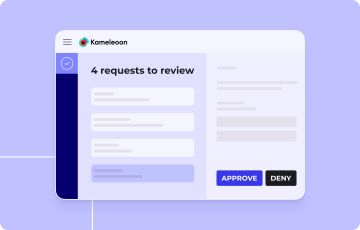Why is a combined PLG and SLG approach most beneficial for growth?
This interview is part of Kameleoon's Expert FAQs series, where we interview leaders in data-driven CX optimization and experimentation. Yves Delongie is the co-founder and CEO at journy.io, a PLG platform that identifies signups most likely to buy, expand, or churn; and lets you engage with them through hyper-personalized sales and CS playbooks.
1 What are the differences and similarities between product-led growth (PLG) and sales-led growth (SLG)?
Product-led growth (PLG) and sales-led growth (SLG) are two different approaches to growing a business. The main difference between them is PLG focuses on creating a product that is so compelling it drives growth, while SLG relies on sales and marketing to drive growth.
PLG and SLG also differ in terms of their priorities and strategies. PLG prioritizes product development and the customer experience, while SLG prioritizes sales and marketing efforts, typically not showing pricing but offering a demo. PLG often relies on self-service models and free trials to attract and retain customers, while SLG typically relies on sales reps to close deals and acquire customers.
Most businesses are using a hybrid of SLG/PLG. They use PLG signals and playbook actions to enrich their initial SLG process. For example, they use a PLG playbook to create a follow-up sales task for an Account Executive. Some call this product-led sales (PLS), but I see PLS as the correct sales workflow within PLG.
2 Why is a combined PLG and SLG approach most beneficial for growth?
Tackling growth through PLG and SLG allows you to leverage the strengths of each approach at the same time. PLG is particularly effective at driving growth through product development and customer experience without customers needing to go via sales. SLG is effective at driving growth through marketing campaigns and sales workflows.
The combined approach covers all the lead-gen bases: PLG acquires new leads through existing customers and has a lower Customer Acquisition Cost (CAC) than SLG. In contrast, SLG will cover the primary sales and marketing channels.
3 How can my company use PLG and SLG without teams pulling in different directions?
What I often see at pure-SLG companies is different customer-facing teams working in silos, each using their own tools and workflows, not collaborating.
One way to ensure that PLG and SLG work together effectively is to establish clear communication and collaboration between the teams. This typically involves transparently setting shared goals and metrics and creating processes for sharing information and feedback. It can be helpful to establish a clear hierarchy of decision-making and responsibilities so that each team knows its role and how they contribute to the overall growth strategy.
Another approach is having the same team handle both—using a general SLG workflow where lead-gen and PLG signals enrich the workflow. A product-led sales framework (seed, land, expand) that asks an Account Executive to reach out to a product-qualified lead can easily be handled by the same people answering an SLG-generated lead.
Often, the sales remuneration system (e.g., bonuses) will need to be adapted so that personal efforts are weighted less than team/company efforts.
4 What do I need to implement PLG and SLG into my business?
Implementing PLG and SLG strategies into your business requires specific tools, metrics, skills, processes, and mindsets. Some key factors to consider:
- Implementing PLG and SLG requires various tools and technologies, such as analytics platforms, customer relationship management (CRM) systems, and marketing automation software. Avoid spending too much on your tech stack by investing in platforms that combine key product, marketing, and sales features you need.
- Measure what’s important. To conduct PLG, you must measure what users do on your platform and their progress toward buying, expanding, or churning. You should use past data to detect early signals about what users will do in the future, but identifying these signals can be daunting. Most organizations approach this challenge by investing vast amounts of money into analytics capabilities. Instead, consider using a modern PLG platform that leverages machine learning to create these signals automatically.
- Get the right people and skills in place. To create the metrics and processes needed for PLG and SLG, recruit a dedicated team with diverse skills, including product development, design, marketing, sales, customer success, and analytics.
- Implementing PLG requires a shift in mindset from traditional sales and marketing approaches. For PLG to be successful, business leaders should focus on creating a product that is so compelling it drives growth through its active users.
5 How can teams use data and insights from growth strategies to inform hypotheses for A/B testing?
Teams can use data from PLG and SLG to inform hypotheses by identifying either:
- Areas where the business can improve.
- Opportunities to try different approaches.
For example, user behavior and engagement data can help identify areas that need improvement in the product or user experience, such as the onboarding flow or feature set.
Sales data can help inform hypotheses around targeting or messaging, and teams can use A/B testing to validate what works best for customers.
Some PLG tools will allow you to trigger different engagement workflows and monitor each against a specific goal. For example, promising freemium/trial accounts can be:
- Sent an engagement email sequence to nurture them.
- OR: Called by an Account Executive prompted by an automatic task.
- OR: Sent a bottle of champagne, thanking them for their freemium subscription. (Just to have a 3rd hypothesis 😉)
After a while, the data should be clear on which workflow converts the most trial users into paying customers.
6 Yves, you have helped many tech businesses grow. Is there a common theme among them that drives their success?
They focus on creating a product people love, are data-driven, understand the importance of experimentation, and are willing to bet the company to change what works into what they know will work much better!
To learn more about how teams are coming together to achieve exponential growth, check out our webinar with top voices in PLG.




